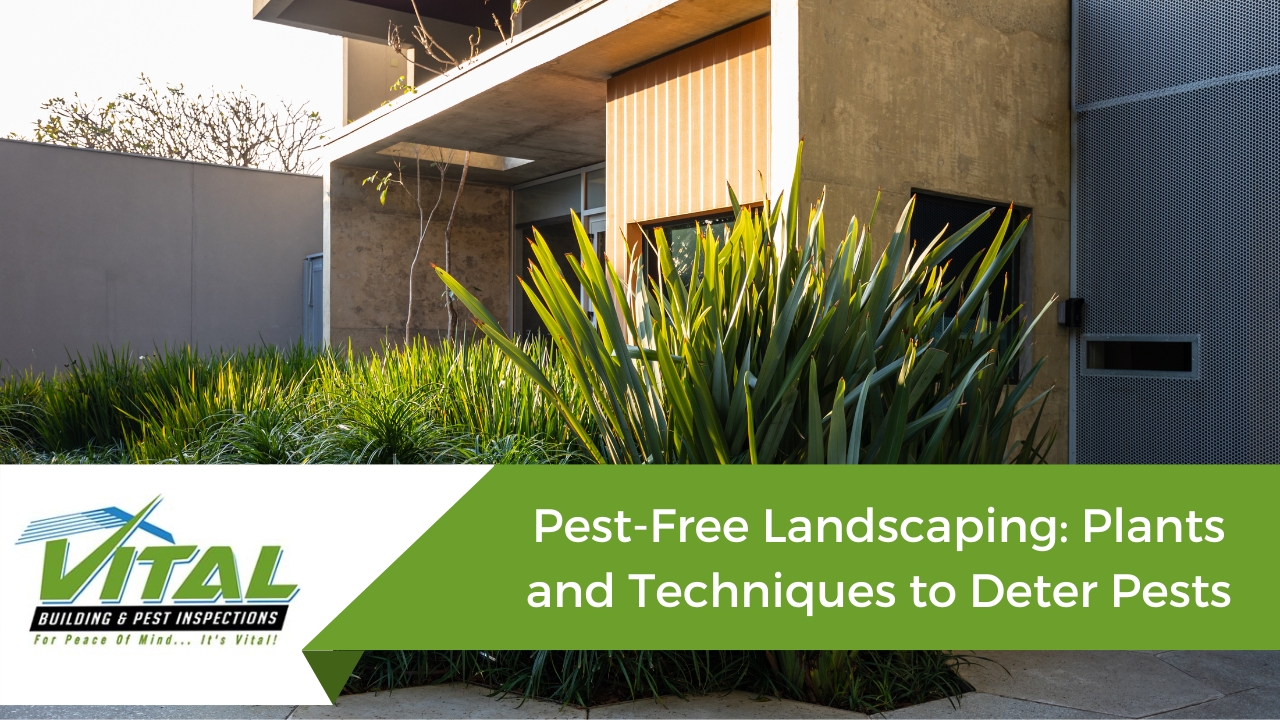Maintaining a pest-free environment around your property is crucial for the structural integrity of buildings and the overall well-being of occupants. As a building inspector, we often encounter issues stemming from pest infestations that could have been prevented with thoughtful landscaping choices and effective techniques. In this article, we’ll explore how to create a pest-resistant landscape by incorporating specific plants and employing proven strategies.

Choose Pest-Resistant Plants
Selecting the right plants lays the groundwork for creating a pest-free landscape. It’s essential to opt for species that naturally possess characteristics to deter common pests or exhibit resilience against infestations. Here are some elaborations on specific plant choices renowned for their pest-repelling properties:
- Lavender: Lavender stands out not just for its aesthetic appeal and aromatic fragrance but also for its effectiveness in deterring a range of pests. Its distinctive scent acts as a natural repellent against mosquitoes, flies, and other airborne insects. This makes it an excellent choice for outdoor spaces, as it not only adds beauty but also contributes to a more pleasant environment by keeping flying pests at bay.
- Marigold: Vibrant and striking, marigold flowers are not only visually appealing but also serve as a natural defence against pests. These flowers contain pyrethrum, a potent natural insect repellent that effectively combats mosquitoes and nematodes. By planting marigolds strategically within your garden or landscape, you introduce a natural barrier that helps prevent the intrusion of troublesome insects.
- Basil: Adding basil to your garden not only enhances your culinary experiences but also acts as a natural pest deterrent. Its aromatic leaves emit a scent that repels mosquitoes and flies, making it a multifunctional addition to your outdoor space. Incorporating basil into your landscaping not only aids in pest control but also provides fresh herbs for cooking, showcasing its dual benefits.
- Chrysanthemums: Chrysanthemum flowers contain pyrethrin, a compound widely recognised for its effectiveness as a natural insect repellent. This natural ingredient is often utilised in various commercial insecticides due to its potent pest-deterring properties. By cultivating chrysanthemums in your garden, you introduce a powerful ally in warding off unwanted insects, thereby contributing to a pest-free environment.
- Mint: The robust aroma of mint plants serves as a natural deterrent against ants, rodents, and spiders. Its strong scent disrupts the olfactory senses of these pests, deterring them from invading your garden or landscape. By incorporating mint into your planting scheme, you not only contribute to pest control but also enjoy the aromatic essence of this versatile herb.
By strategically incorporating these plants into your landscaping design, you not only enhance the aesthetic appeal of your outdoor space but also establish a natural defence system against a range of common pests, fostering a more harmonious and pest-free environment.
Implement Companion Planting
Companion planting involves strategically placing plants that support each other’s growth and repel pests. For instance:
- Planting basil near tomatoes can help protect tomatoes from aphids and other pests.
- Growing nasturtiums can deter whiteflies and squash bugs while attracting beneficial insects.
- Pairing marigolds with vegetables like beans and tomatoes can discourage nematodes.
Maintain Proper Plant Spacing and Pruning
Maintaining proper spacing between plants is a crucial aspect of landscaping that significantly contributes to a healthier garden environment. This practice facilitates adequate air circulation, which plays a pivotal role in reducing the risk of fungal diseases and minimises opportunities for pests to thrive. Additionally, regular pruning is an essential gardening task that goes beyond mere aesthetics; it’s a fundamental practice for the overall health of your plants and acts as a strategic measure against pest infestations.
Adequate Spacing for Air Circulation
Properly spacing plants is akin to providing them with ‘breathing room.’ This allowance between plants ensures that they aren’t overcrowded, which can lead to restricted airflow. Adequate air circulation is critical as it helps to dry foliage faster after rainfall or irrigation, reducing the likelihood of fungal diseases like mildew or mould. Additionally, improved air circulation discourages the buildup of humidity, creating an environment that is less conducive to the proliferation of various pests.
Reduced Hiding Spots for Pests
When plants are spaced appropriately, there are fewer areas for pests to take refuge or establish colonies. Pests often thrive in dark, cramped spaces where they can breed and multiply without disturbance. By maintaining proper spacing between plants, you effectively limit these hiding spots, making it more challenging for pests to infest and proliferate within your garden or landscape.
Regular Pruning for Pest Management
Pruning serves as a proactive measure in pest management. Removing dead or damaged plant material not only enhances the aesthetic appeal of your garden but also eliminates potential breeding grounds for pests. Dead or decaying plant parts can attract pests, providing them with a hospitable environment to thrive. By promptly removing these areas through regular pruning, you disrupt the pest’s lifecycle and reduce their ability to establish a foothold in your garden.
Maintenance of Plant Health
Beyond pest prevention, proper spacing and regular pruning contribute significantly to overall plant health. Pruning promotes stronger growth, encourages the development of a more robust plant structure, and enhances the plant’s ability to resist pest attacks. Furthermore, by maintaining healthy plants through appropriate spacing and pruning, you create a less inviting environment for pests, as healthy plants can better defend themselves against potential threats.
Mulching for Pest Control
Applying organic mulch around plants helps retain soil moisture, suppress weeds, and regulate soil temperature. Additionally, certain types of mulch, such as cedar or pine, have natural pest-repelling properties. Mulching also creates a barrier that makes it difficult for pests to reach the plant roots.
Integrated Pest Management (IPM) Techniques
Integrated Pest Management combines various strategies to control pests effectively while minimising the impact on the environment.
Key IPM techniques include:
- Regularly inspecting plants for signs of pest damage.
- Using insecticidal soaps and neem oil for targeted pest control.
- Encouraging natural predators, such as ladybugs and predatory beetles, to keep pest populations in check.

Expert Building Inspections You Can Trust
By incorporating pest-resistant plants and employing smart landscaping techniques, you can create a beautiful and pest-free environment around your property. As quality and innovative building inspector, we at Vital, encourage homeowners and landscapers to prioritise these practices, not only for the aesthetic appeal but also for the long-term health and resilience of buildings and the people who inhabit them.
Ready to ensure the safety and integrity of your property? Contact Vital Building Inspections Sydney today – the clear choice for timely, thorough, accurate, and professional building inspections in Sydney. Don’t compromise on the quality of your property assessment. Reach out to us now to schedule your inspection and gain peace of mind for your investment. Call us on 0401012074.






